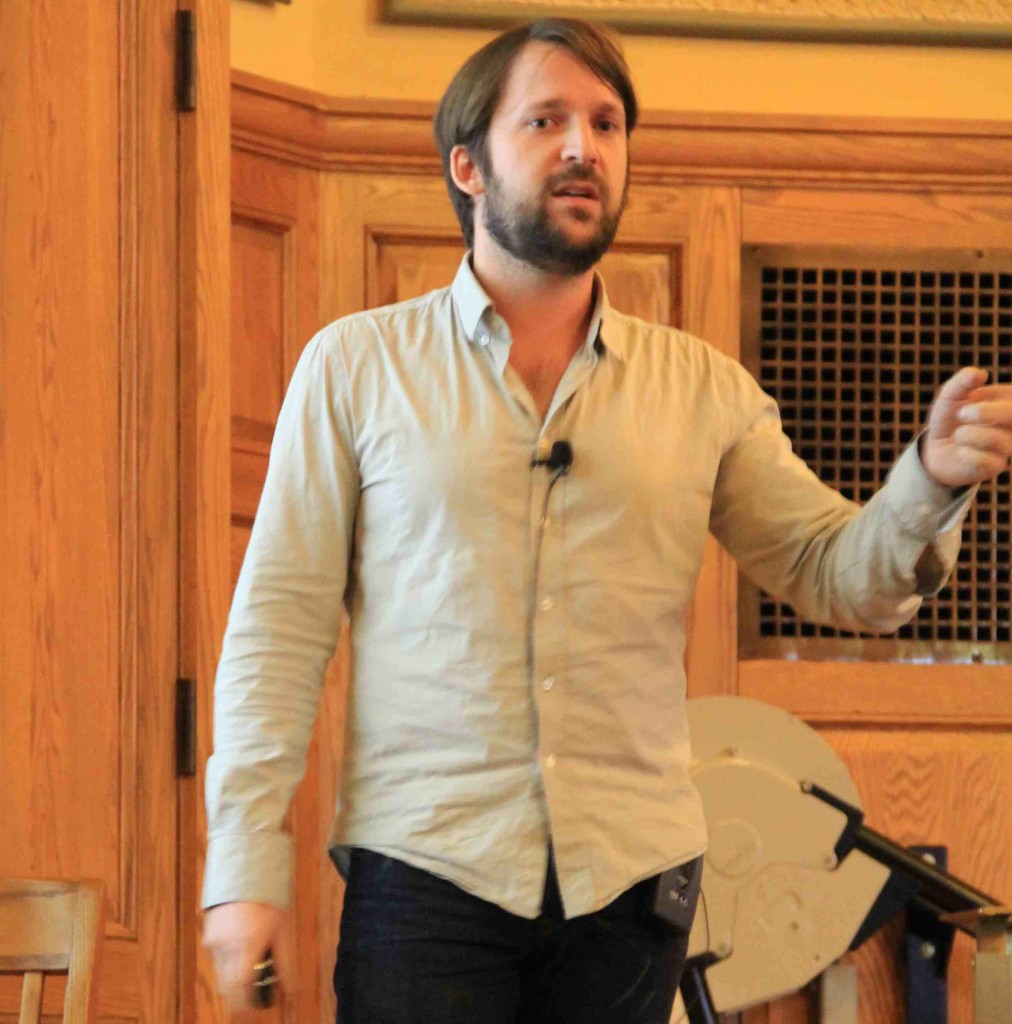René Redzepi was born to a Danish mother and Macedonian father. “I come a little bit from outside,” he explained in a 2010 interview. “I don’t see things as 100 percent native.”
To this he attributes his success. He is 33 years old and renowned in the culinary world for a devotion to local ingredients and foraged foods. This is a challenge in Scandinavia, a part of the world “where most people think cooking can’t exist,” he says. “But if you use your intuition and see the possibilities, it’s happening.”
Redzepi co-founded the Nordic Food Lab where he champions waste-less food production. He refers to farmers as “the true artisans” and has transformed the fad of environmentally friendly sourcing into an art form. He works 80 to 100 hours per week because he loves his work, and when this love begins to fade, “if you are in doubt, you invite friends and you remember that feeling of giving,” he says.
Redzepi is the chef and owner of Noma, a 12-table waterside restaurant in a Copenhagen warehouse. This year and last, Noma was nominated the S. Pellegrino Best Restaurant in the World.
I spoke with Redzepi about his work after a recent public talk hosted by the Yale Sustainable Food Project.
Julie Botnick: How did you first begin to focus on local, sustainable sourcing?

René Redzepi: We started out of necessity. [Foraging] gives you much more abundance than you can find in a supermarket. If ingredients are your alphabet, foraging gives you a ten-fold vocabulary to explore. By searching for ingredients, you start to explore, read about them, how they’re grown. They become a natural part of your cooking.
Botnick: You talked about a very hard winter when you were on a desperate search for local ingredients, which led to your love affair with “a very old carrot,” a carrot that had been in the ground for over a year without harvesting. When cooked as tenderly as a cut of meat, the “vintage” carrot was a delicious meal. You also talked about your discovery that seaside arrowgrass tasted just like coriander. What have been some of your other most and least successful ventures?
Redzepi: There hasn’t really been one big one; there have been thousands of failures and successes. You fail much more than you succeed. It rains, and the ingredients you had yesterday, tomorrow you no longer have. Getting to know how seasons work, feeling what type of year you’re in… that type of connection has been our biggest success.
Botnick: How do you see the ideas and creativity of Noma being incorporated elsewhere?
Redzepi: It’s something that’s happening everywhere. At Noma, we have 40 people on our kitchen staff alone, so there’s always a huge shift in and out, and many of them are opening their own restaurants. I see the restaurant as a school, where we are teaching cooks other ways of thinking.
Botnick: In addition to Noma, you are known for your work with the Nordic Food Lab, which studies traditional Nordic gastronomic techniques and celebrates Nordic roots while promoting innovation. What is the importance of research and development in your business?
Redzepi: It plays a very big role; we are known for our innovation. Everything is about gaining new knowledge – constantly: knowledge about ingredients, growing ingredients, and the science behind this. We never stop learning. It’s a perfect mixture of what makes sense for the most delicious result. We’re on the cutting edge of technology, and we shouldn’t be afraid of that. There’s a big difference between technology and chemistry.
Botnick: What is the biggest way others can support your work?
Redzepi: We need facilities that are knowledge tanks and banks for people cooking. This way, chefs don’t have to spend the whole night researching, reading, and doing other prep work after a full day of cooking. For example, we created the Nordic Food Lab because we were just too busy as cooks.
Botnick: How does our American food system relate to the European system?
Redzepi: It’s impossible to compare. America is so big; there are so many different worlds of food, different legislations. You have these mega-industries. At the same time, Denmark is so inspired and influenced by America in its policies. There are similarities in that people eat substantial amounts of fast food, and they don’t cook as much as they should. As a selfish restaurateur, the more people that have no relation to food, the less people will come to the restaurant. They won’t understand why some carrots cost ten times more and why there is no meat on their plates. The whole idea behind changing the food system is to keep educating people so they will learn more, and come to these realizations by themselves. If they become knowledgeable without somebody lecturing them, then they will be able to make their own decisions.
Botnick: You raise an interesting issue—as the owner of the best restaurant in the world, with hundreds of thousands of calls for reservations each year, how do you think we can make this model of sustainable food affordable?
Redzepi: People have to know how to cook. You can do amazing things with lentils, a carrot, and a drop of olive oil. Nettles, for instance, are wild, free, and great ingredients. The whole idea that food can be done in 30 minutes is utopian. To learn how to cook simple food, you have to begin by cooking food for a long time. The more you know it, the more cheaply you can do it. We just have to be connected again to cooking, to know how to use everything from a plant or vegetable. We cut the green off an onion, but you can actually salt and ferment it.
For more of your Scandinavian cooking fix, sign up (way in advance) for a reservation at Noma, peruse a great Noma-themed slideshow at the NY Times, or watch a video from The Guardian below: